Search Results for 'Fredric Brown'
Did you find what you wanted ?
Sun 10 Feb 2019
I’ve asked Greg Shepard, publisher and editor-in-chief at Stark House Press, to tell us what’s come out from them recently or what will be showing up soon. He has most graciously agreed:
News from STARK HOUSE PRESS
by Greg Shepard
This year Stark House Press will celebrate being in business for 20 years. Our first book was a hardback collection of fantasy stories by Storm Constantine. We followed that with a few more Constantine projects, then jumped into Algernon Blackwood territory, a supernatural sidestep on our way to crime.

Twenty years in the publishing business has brought us full circle; in January, 2019, we published the definitive biography of Algernon Blackwood by Mike Ashley — The Starlight Man. This is not only the first paperback edition, but also the most complete version, since Ashley added back in all the bits his UK hardback publisher asked him to take out back in 2001, with lots of new pictures as well.
Although our primary focus has mainly been “men’s†hardboiled, noir fiction of the 40s to the 60s — our lead title for January was Lead With Your Left and The Best That Ever Did It by Ed Lacy, two gritty, New York cop mysteries — we recently began adding more of the women’s suspense authors from that era, too. In November of 2018 we issued End of the Line by Bert & Dolores Hitchens as part of our Black Gat series. This is one of five railroad mysteries that Dolores wrote with her rail-detective husband, Bert. But Dolores also wrote a lot of fine standalone mysteries during the 1950s, and we will be bring six of those back over the next couple years, starting with Stairway to an Empty Room and Terror Lurks in the Darkness next fall.

In February, we will be proudly publishing two novels by the incomparable Jean Potts. She won the Edgar Award for one them, Go, Lovely Rose, and was nominated for the other one, The Evil Wish. Both are excellent novels of psychological suspense, the first story dealing with the murder of a woman whom everyone in town hates, the second concerning a murder that is planned but not executed, leaving distrust and suspicion in its wake. Booklist has already labeled these “two masterpieces†and we’re excited to be bringing them back, with more to come.
Stark House will also be reprinting the works of Bernice Carey and Helen Nielsen. Back in November of 2016 we reprinted Woman on the Roof by Nielsen, and in May we have two more of her clever Southern California mysteries to offer: Borrow the Night and The Fifth Caller. Also in May we will be publishing (for the first time in paperback) Carey’s The Man Who Got Away With It and The Three Widows. Carey set her novels in small town California where she lived, often peppering them with her own brand of social justice. As Curtis Evans says in his introduction, “the most significant contribution of Bernice Carey to mid-century crime fiction was her commitment to exploring realistic social conditions in her novels.” She also created some very interesting characters.

Over in the noir camp is one of my personal favorites, Gil Brewer. We published two of his noir thrillers, The Red Scarf and A Killer is Loose, back in October. Brewer was the master of momentum. He’d create a desperate situation for this protagonist—usually involving lots of cash and a young, willing woman — and turn him loose to frantically pursue each with equal amounts of sweat and lust.
This year, we are reprinting Redheads Die Quickly, the definitive collection of Brewer stories edited by David Rachels back in 2012, with five new ones added. And later this year we will be complementing this volume with two new Brewer collections: Death is a Private Eye, set for August, and Die Once — Die Twice, tentatively scheduled for early 2020; each volume edited and introduced by David Rachels.

In March, Stark House is following up its Carter Brown program with three more Al Wheeler mysteries: No Law Against Angels, Doll for the Big House and Chorine Makes a Killing. If you don’t recognize these titles, that’s because No Law was published here as The Body (the very first Brown book to be published in the U.S.) and Doll as The Bombshell.
Back in the late 1950s, when Brown’s Australian publisher started to populate the world with his books, the feeling was that they needed Americanizing. So these first few Wheeler stories were revised for the U.S. audience. I thought it’d be more fun to reprint the original Australian versions, so that’s what we’re doing. In fact, Chorine has never been published in the U.S. at all, so that’s a first for most American readers.
Those are just a few of the highlights. There’s more: Jeff Vorzimmer has edited the mammoth The Best of Manhunt and will be discussing it in a separate post. That’s our big summer title, set for July. I am also working on a second trio of Lion Book noirs, another two-fer of Barry N. Malzberg satires (The Spread and The Social Worker), our final Peter Rabe volume (New Man in the House and Her High School Lover), plus lots of odds and ends over at Black Gat Books, including authors like Noël Calef, Ovid Demaris, Fredric Brown and Louis Malley.
Tue 25 Apr 2017
WINDY CITY PULP CONVENTION 2017 REPORT
by Walker Martin
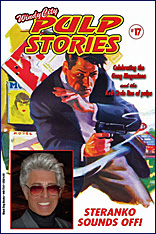
I believe there have been 17 versions of this excellent pulp and paperback convention and this may have been the best yet. 150 dealer tables and almost 600 attendees. This is the biggest crowd yet and the room seemed to be constantly busy with collectors prowling the aisles.
It all started with the usual group of serious and perhaps deranged pulp collectors driving out from New Jersey in a rental van. Between the five of us, we have more than 200 years of experience collecting books and pulps. In prior years we managed to make the trip in one death defying drive of 14 hours but this year we decided to split it up and take two days. The first day we drove about 11 hours before stopping at a motel which appeared to be connected to the Bates Motel in Psycho. The night clerk certainly thought we were a suspicious looking group because she refused our business and sent us on our way. Fortunately there was a Ramada Inn down the road and they were used to a van full of book collectors stumbling into the lobby.
The next day we drove three hours to the Chicago Pulp Art Museum, otherwise known as the house of Doug Ellis and Deb Fulton. Each year Doug and Deb have a pulp art luncheon for those collectors who love pulp and paperback original cover paintings. It’s a nice beginning to a great convention. Despite a recent addition the house is bulging with original art. Perhaps Doug can build another house in his back yard to house more paintings.
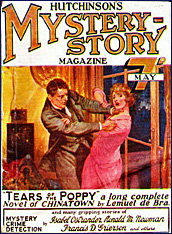
We then drove to the Westin Hotel and arrived in time to hang out in the Con Suite. This year my room was just down the hall on the 16th floor and made it easier for me to drink free beer and snacks. I renewed friendships with several collectors, most of whom I had not seen in a year or two. Unfortunately, I have now reached the age where I don’t recognize fellow collectors if I only see them once a year, so please accept my apologies if I ignored you or seemed to not recognize you. My eyesight is fading and old age is bothering the hell out of me, so several times I passed someone and then a minute later moaned “Oh hell, that was so and so, and I looked right through them.” Fortunately some collectors had canes or were limping or like Tony Tollin had a pet dog. That made it easier to recognize them….
Even all these years later, I still get excited when I enter a room full of books and pulps. At first I sort of stumbled down an aisle in a daze obviously suffering from sensory overload. But unlike a J.G. Ballard character, the books did not start to disappear from my sight. Instead they multiplied and I began to wonder which table to go to first. Should it be the table surrounded by cover paintings and art? Maybe the one loaded with vintage paperbacks? How about the boxes of digest crime and SF magazines? Damn it, there are rows and rows of pulps! Wait a minute, some old friends are waving to me…
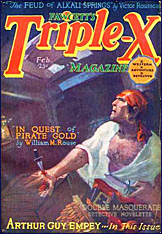
But then I saw a table that really stood out because all three dealers were British. So over I went to Malcolm Edwards, Alastair Durie, and Andy Richards (Cold Tonnage Books). I figured for them to make the trip across the Atlantic, they must be bearing some rare items. And they were! I even saw issues of the amazingly rare Hutchinson’s Adventure or Mystery magazine. WW II was really rough on some British magazines. (The paper drives.) But what I really scooped up were issues of Scoops, the 1934 British SF magazine. A complete set of all 20 issues.
Then I found twelve issues of Triple X. The title stands for the three genres of westerns, adventure, and detective fiction. Not the risque meaning that triple x has nowadays. Why this magazine is so rare is beyond me. It lasted for over 100 issues in the twenties and thirties and seemed to be quite popular with readers. Yet copies are hard to find and expensive.
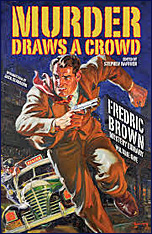
So OK, I’ve blown $1500 in a few minutes, and I still have three days of the convention to survive somehow. Will this be the pulp show that finally breaks me? Will I return home a penniless beggar? Will I have to borrow money, maybe skip meals? God Forbid, Go On the Wagon? The answer is no. Maybe next year. But I did find some more of my esoteric wants, such as Ace High, Cowboy Stories, Dime Detective.
Since we live in The Golden Age of Pulp Reprints, I filled up a box of recent books from Altus Press, Haffner Press, Black Dog Books, Murania Press, and also the book Weinberg Tales, which is almost 300 pages of Bob Weinberg on Collecting Fantasy Art, plus memories from fellow collectors like me and plenty of photos.
The reprint publishers have really done a great job and these recent books show an excellent sampling of the type of reprints. For instance Haffner Press (Haffnerpress.com) has just published two Fredric Brown collections which gather together all his mystery short stories. The titles are Murder Draws a Crowd and Death in the Dark, ,with introductions by Jack Seabrook who wrote a book on Fredric Brown. The stories also reprint the original illustrations. Highly Recommended!
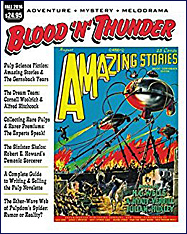
Altus Press had a boat load of books available and I especially recommend Leo Margulies: Giant of the Pulps by Philip Sherman and Gales & McGill, Volume One, by Frederick Nebel. A nice long introduction by John Locke, this book reprints the air adventures of these two flying soldiers of fortune. Also Altus Press has the latest two issues of Black Mask and Famous Fantastic Mysteries. The pulps are not dead!
Murania Press had the last issue of Blood n Thunder out. This is issue number 49 & 50 and it was a great run lasting 16 years. We now will see one shot issues on various topics. Also out from Murania is The Blood n Thunder Sampler which reprints some of the best articles from past issues.
Black Dog Books had several new collections out, and I liked The Trail of Blood and Other Tales of Adventure by Murray Leinster. Also Paths of Fire and Other Daring Tales of Adventure by Albert Richard Wetjen.
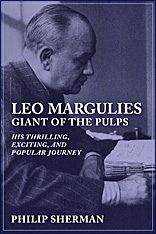
Every year the convention has a book titled Windy City Pulp Stories. Issue # 17 has several articles dealing with the Gangster pulps and the Red Circle Publications. Also pieces on Steranko, artist Tom Lovell, and David Kyle. Tom Roberts of Black Dog Books is the editor and does a fine job each year.
It’s worth going to this convention to meet and talk with other collectors about their passions. I’ve known artist Peter Poplaski for a long time and though he lives in France, I’ve seen him at several conventions. He is one of the top experts on Johnston McCulley and Zorro. This year he kept me amused with over a dozen masks that he had made of McCulley’s characters. He has now identified over 20 of them.
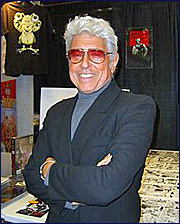
Windy City is known for its great auctions which run far into the night on Friday and Saturday, This year we had about 300 lots each night, mainly from the collection of Ron Killian. The catalog had a great photo of Ron Killian surrounded by towering stacks of pulps. Though I prefer book shelves, I can understand tall stacks also! All type of genres were represented in the auctions and the prices ranged from high to low, with many bargains.
The Guest of Honor was artist Jim Steranko, and he gave a speech and was available at his table to sign items. The art show was stunning with mainly pieces of art from the collection of Bob and Phyllis Weinberg. There was a Weinberg Tribute panel Friday night and I was honored to be part of it since I had known Bob since the late 1960’s and early 1970’s. In other words I was friends with Bob Weinberg when he still lived in New Jersey and was in his twenties. It really does not seem that it has been 45 years ago when we both started off building our collections.
Ed Hulse organized the film program as usual and the theme was “From Pulp to Silver Screen.” These were mainly obscure pulp related movies. Each movie was described in the Windy City Pulp Stories book.
We need this convention to keep the pulps alive so Doug Ellis, Deb Fulton, John Gunnison and others, all deserve our thanks. Next on the horizon is Pulpfest (Pulpfest.com) in July. If you liked Windy City, then you have to attend Pulpfest also. I ought to know, since I’ve been attending these shows most of my life!
Sun 26 Feb 2017
REVIEWED BY DAN STUMPF:

CHARLES EINSTEIN – The Bloody Spur. Dell 1st Edition #5, paperback original, 1953. Black Curtain Press, softcover, 2013.
WHILE THE CITY SLEEPS. RKO, 1956. Dana Andrews, Rhonda Fleming, George Sanders, Howard Duff, Thomas Mitchell, Sally Forrest, Ida Lupino, James Craig, Vincent Price, John Drew Barrymore. Robert Warwick. Screenplay by Casey Robinson, based on the novel The Bloody Spur by Charles Einstein. Directed by the one & only Fritz Lang.
Okay. At the time of this writing, and from all I can tell, this is the earliest film to be based on a paperback original. I’m open to other suggestions.
Einstein’s book is what I call a novel-novel: a diverse cast of characters interacting in a dramatic but realistic situation, having affairs, changing jobs, getting drunk, palling around, quarreling and otherwise getting some drama into their day-to-day lives.

In this case the impetus is the death of the second-in-command at the Kyne Publishing empire (the book opens, in fact, at his funeral) and the hustling of high-ranking underlings to get promoted to his place. As a sub-plot, there is a serial killer terrorizing New York and the race to the near-top quickly devolves into a competition to be the first with the scoop on the identity of the killer, an undertaking that turns into detective work, seduction, betrayal, and more drinking — these newsmen all act like they think they’re in a Fredric Brown story.

Einstein does a capable job of cutting between them, though: a crusty old newspaper editor, an ambitious chief of wire services, a lascivious female columnist and a philandering ad man, punctuating the story with some catchy lower-level lives: a smart crime reporter, another not-so-smart reporter, cops, secretaries… and the killer himself.
I said “capable†not “brilliant.†The Blood Spur will keep you reading, but it’s not the sort of thing one remembers for long or with a great deal of affection: passable but not much more. Surprising then that the film made from it is (to use a hack’s pet phrase) so gripping and suspenseful.

Well, maybe not all that surprising. Director Fritz Lang mastered the Movies in the 1920s, adapted to social commentary in the 30s, moved to international intrigue and film noir in the 40s, and the 50s found him still attuned to the times, with an edgy rock-and-roll tempo that seems to roar right out of The Wild One.
Of course it helps that he had a cast like that. Dana Andrews and Sally Forrest play the reporter/secretary couple with affection that never turns to cuteness, George Sanders is his reliably scheming self, playing nicely off Thomas Mitchell’s ink-stained editor, and Vincent Price is agreeably slimy as the big boss manipulating them all. Also I should make special mention of Ida Lupino as the -um- flirtatious columnist radiating no-nonsense sex appeal that contrasts nicely with Rhonda Fleming’s duplicitous trophy wife.

With a few exceptions (which I’ll get to later) Casey Robinson’s screenplay follows Einstein’s novel closely — sometimes eerily so. Little bits of business, place names and odd phrases like “in cold daylight†appear on the screen with surprising faithfulness in a medium that was never known for its fidelity. But the changes are even more significant.
Starting with the ending, well, in the book it’s pretty prosaic; the killer tries to assault a stranger â€in cold daylight,†a chase through the subway tunnels ensues, and if you can’t guess the outcome I won’t spoil it for you except to say one of our intrepid newsmen gets the scoop. In the film however, reporter Dana Andrews decides that the best way to catch the killer is to use his fiancée as bait, putting a personal and more involving twist on the proceedings.

(PARENTHETICAL NOTE: I don’t know about you, but to me having your betrothed use you as the potential victim of a mad killer is a sign that this relationship may be in trouble. I’m just saying….)
Another note of interest: in the novel, the killer obsessively reads the Bible; in the movie, he’s had his mind warped by Comic Books, and thank you, Dr. Wertham; I don’t think the Legion of Decency would have let them get away with that anyway.
And finally, there’s a delicious in-joke near the beginning: The book kicks off with the death of the second-in-command at Kyne Enterprises; in the film the story is kicked off by the death of the patriarch himself, leaving his son (Vincent Price) to select someone to actually run the damn thing. Price lets the competition hinge on a comment his late daddy made about catching the serial killer – thus making While the City Sleeps the second film centered around the last words of a dead publisher whose name starts with “K.â€
No prizes for guessing the first.
Sat 12 Nov 2016
DASHIELL HAMMETT “The Gutting of Couffignal.” Black Mask, December 1925. [+] RAYMOND CHANDLER “Red Nevada.” Black Mask, June 1935. Both stories have been reprinted many times, including a joint appearance in Great Action Stories, edited by William Kittredge & Steven M,. Krauzer. Mentor Book, paperback original, May 1977.

I came across the Kittredge & Krauzer paperback one day a short while ago, and I decided to bring it along on a recent cross-country flight I made. I’m glad I did. Other than the stories above, it also includes stories by Mickey Spillane (“I’ll Die Tomorrow”), Len Deighton, Fredric Brown, Robert L. Fish and a number of others, the names of most of whom I’m sure would be readily recognizable to everyone who visits this blog on a regular basis.
But the two authors featured at the top of those listed on the front cover are Dashiell Hammett and Raymond Chandler, the two most famous proponents (if not out and out creators) of the “hard boiled” school of writing, bar none. And while the two stories the editors selected are alike in some way, in others they are as different as night and day.
The plot of “The Gutting of Couffnignal” is the simpler and more straight forward of the two. The Continental Op has been hired to watch a table filled with wedding gifts overnight on a island in San Pablo Bay off the California shore, connected only by a single bridge.

An easy job, or it would have been if a gang of robbers armed with machine guns and other weapons doesn’t attack the island, blowing up the bank and a jewelry store with dynamite, and killing scores of people in the process. With the help of a family of Russian expatriates, the Op assumes the responsibility of coming to the aid of the entire island, and that he does.
The action is fast and furious, but the Op shows that all the while he’s on the move, he’s thinking too, and the ending is as hard boiled an ending as you imagine. It’s a story that once begun, you won’t put down until you’re done, with Hammett fully in charge with clear,clean prose.
“Nevada Gas,” Raymond Chandler’s tale of personal warfare between some top gangsters in the city of Los Angeles, is as hard boiled as Hammett’s, but the story is a lot more complicated and filled with some subtle nuances that can easily take you more than one reading before you decide you’ve caught them all.

Two scenes in particular stand out. In the first a heavy set crooked lawyer named Hugo Candless is taken for a ride in a limousine mocked up to look like his own, but it is not, and what’s more, it’s rigged to delivered a dose of fatal gas to anyone who finds himself trapped in the back seat.
The second, almost unnecessary to the plot finds a guy named Johnny De Ruse, who’s also the main protagonist, having escaped the same trap himself, going to a gambling place and faking his way into seeing the one responsible by making a scene in a crooked casino room.
As opposed to the Hammett story, Chandler’s zigs and zags, giving the reader only brief glimpses of a connected tale, but connected it is. Chander’s prose is lot more ornate, and the ending is much more quiet, but to my mind, it’s equally effective.
Question: If you’ve read both, which story did you like better? Which author tickles your fancy more?
Tue 23 Feb 2016
Reviewed by DAN STUMPF:

LOVE-SLAVES OF THE AMAZONS . Universal, 1957. Don Taylor, Gianna Segale, Eduardo Ciannelli. Written, produced & directed by Curt Siodmak. Second unit direction: Terry Morse.
I saw this when it first came out on a double-bill with The Monolith Monsters at my neighborhood movie house, and once again I observe that you got Bang for your Quarter in those days….
Curt Siodmak always struck me as the cinematic equivalent of Fredric Brown: an unredeemed and unapologetic pulpster who reveled in the gaudy, tawdry delights of things like Son of Dracula, Bride of the Gorilla, and this kaleidoscopic comic book of a film; very bad, but fun nonetheless.

Don Taylor (who directed some very bad films himself later on) stars as world-famous archeologist Dr. Peter Masters, who arrives in Brazil, just why we’re never told, and is almost immediately accosted by Eduardo Ciannelli as Dr. Crespi. (The name is an in-joke.) a local crackpot who claims to have visited the Lost City of the Amazons etc. etc…. it’s all very familiar, but done with speed and economy in lieu of originality or artistry.
Indeed, Writer/Producer/Director Siodmak peels the old banalities right off the yellowed pulp pages and slaps them across the screen with a shamelessness that borders on daring — which was just fine for this skinny seven-year-old of the 1950s. We get fist-fights, river pirates, alligators, drugs, snakes…. and some rather uninspiring Amazon Warriors with their skin painted green. Ah yes!

That’s what has stayed with me through the decades: the look of this thing; parts of it were filmed on location in Brazil (apparently by Terry Morse, who did the Americanized scenes in Godzilla) and parts on studio sets so brilliantly colored that one suspects the art director may have been using controlled substances. We get blue jungle, green-skinned blondes, a massive temple made of brightly-painted cardboard, and clumsy dancing girls decked out more like rodeo clowns than pagan beauties.
We also get a couple of gruesome off-screen deaths, but I the problem is that we never get a good pay-off scene: no suspenseful cliff-hanging, no climactic struggle… not even a guy in a gorilla suit. This didn’t bother me as a kid, but in the wisdom of my advancing years I see the lack of a last-reel ass-kicking as a deplorable aesthetic oversight. And the deficiency in the gorilla-suit department elicits a wistful sigh of disappointment.
Still and all, it’s hard to resist a title like Love-Slaves of the Amazons, and it’s a fun film to watch, if you’re wearing sunglasses or have your judgment impaired by the influence of a controlled substance.
Sat 29 Nov 2014

WILSON TUCKER – To Keep or Kill. Rinehart & Co., hardcover, 1947. Lion #21, paperback, 1950; Lion Library LL84, 1956.
Tucker, who is probably better known today for his science fiction, wrote a total of five Charles Horne mysteries for Rinehart back between 1946 and 1951. After that he apparently decided he was better off not trying to write detective fiction, even as a sideline.
Not that he left the field completely, but I think he probably made the right decision.
Horne is a private eye. Most of his work is done for insurance companies. He quite vehemently does not do divorce work. The small metropolis of Boone, Illinois, where he has his office, is a figment of Tucker’s imagination, although there is a Boone County (up near Rockford).

This is the second Horne book. As it begins, he is witness to an explosion. He thinks it’s a practical joke at first, but when it goes off it takes part of a city block and a couple of victims with it. Later, Horne is kidnapped and kept a prisoner in the home of the girl who planted the bomb. She’s a redhead, tall, beautiful, and as loopy as a loon.
She is in love with Horne, she has been stalking him for months, and now that she “owns” him, so to speak, she expects — well, this was written before such explicit intentions could be stated, but those are the kinds of intentions she has. Viewed from today’s more permissive perspective, Horne’s brave resistance to temptation seems both admirable and refreshingly naive.

Tucker’s style in this book is a burbling, slap-happy one, somewhat reminiscent of Fredric Brown in nature. In all, however, it hardly manages to disguise a total apparent lick of respect for logical thought processes. Or let me put it another way: the sort of logic that is used by all concerned would make sense only to the well-confined inmates of a lunatic asylum.
It wouldn’t be hard to enjoy this quirky excuse for a detective story immensely. There is a thin line, it is said, between genius and lunacy. If I’d been able to follow the plot at all, I’d have said this was the work of the former.
As for a letter grade, I’m not too sure of this one at all, but if it means anything to you, what I’m going to do, if I don’t change my mind tomorrow, is give this book a definite (C plus?).
— Reprinted from The MYSTERY FANcier, Vol. 5, No. 3, May/June 1981.
The Charles Horne series —
The Chinese Doll. Rinehart, 1946. Dell Mapback #343, 1949.
To Keep or Kill. Rinehart, 1947. Lion #21, 1950.
The Dove. Rinehart, 1948.
The Stalking Man. Rinehart, 1949. Mercury Mystery #150, no date.
Red Herring. Rinehart, 1951.
Sat 29 Jun 2013
TWELVE ANTHOLOGIES OF
HARD-BOILED & NOIR STORIES:
A List by Josef Hoffmann
The selected anthologies contain mostly short stories from Black Mask and similar pulp magazines. Several stories are newer. The books are especially recommended to readers who want to get a representative overview of this kind of crime fiction without investing the time, money and labour to obtain the original magazines.
These books are also of interest for collectors who want to take care of their gems and prefer to read the old texts in new books. But my list is not complete. More such anthologies have been published than I have selected.
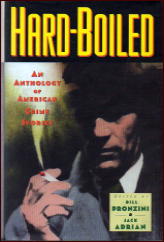
Adrian, Jack & Pronzini, Bill – Hard-Boiled: An Anthology of American Crime Stories, Oxford University Press, 1995.
This is a de luxe edition of an anthology, not only concerning the contents but also the quality of the paper and the book cover. The long and brilliant introduction tries to define hard-boiled crime fiction. Then follow 36 stories from the 1920s to the 1990s. There are the big stars like Hammett, Chandler, W. R. Burnett, James M. Cain, Chester Himes, Mickey Spillane, Jim Thompson etc., but also forgotten writers like William Cole, Benjamin Appel, Jonathan Craig, Helen Nielsen and others.
Among the contemporary authors you find Elmore Leonard, Margaret Maron, James Ellroy, Andrew Vachss, Faye Kellerman. One of the finest stories is contributed by James M. Reasoner, a story in a slightly depressive mood. Every story is introduced by an informative note, so the book is also a reference work. As far as I can remember it was nominated for an Edgar award, which is no surprise for any reader of this anthology.
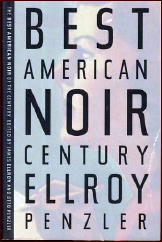
Ellroy, James & Penzler, Otto – The Best American Noir of the Century, Houghton Mifflin Harcourt, 2010.
This book of 731 pages contains more stories of contemporary writers than of old ones. There is no text of Hammett, Chandler, Horace McCoy and Paul Cain. But there are stories by MacKinlay Kantor (“Gun Crazy”), Dorothy B. Hughes, David Goodis, Charles Beaumont (“The Hunger”), Jim Thompson, Patricia Highsmith and others.
Among contemporary writers you find James Ellroy, James Lee Burke, James Crumley, Jeffery Deaver, Joyce Carol Oates, Lawrence Block, Dennis Lehane, Andrew Klavan, Elmore Leonard, Ed Gorman and other writers which are not so well-known. The most recent story was published in 2007: “Missing the Morning Bus,” by Lorenzo Carcaterra. The book starts with a short foreword by Penzler and an even shorter introduction by Ellroy. Informative notes on the authors are added to each story. It is good value for your money.
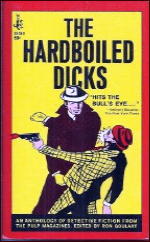
Goulart, Ron – The Hardboiled Dicks. An Anthology of Detective Fiction from the American Pulp Magazines, T. V. Boardman 1967.
Goulart’s book contains stories by Norbert Davis, John K. Butler, Frederick Nebel, Raoul Whitfield, Frank Gruber, Richard Sale, Lester Dent and Erle Stanley Gardner. Four were published in Black Mask, the rest in other pulp magazines.
Goulart’s introduction and his introducing notes for each story are rather short, also the informal reading list at the end of the book. As a hardcover edition of the Boardman’s “American Bloodhound” series with a jacket design by the legendary Denis McLoughlin, this book is a much-sought collector’s item.
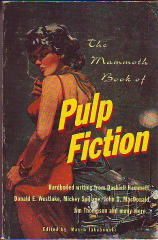
Jakubowski, Maxim – The Mammoth Book of Pulp Fiction, Robinson 1996.
Jakubowski is not only an editor of crime fiction but also a writer of erotic crime novels and the owner of the London bookshop Murder One, which unfortunately does not exist anymore. Jakubowski’s anthology is different from other pulp collections on my list because he presents above all short fiction of Gold Medal Book authors like Charles Williams, John D. MacDonald, Gil Brewer, Jim Thompson, David Goodis, Day Keene, Bruno Fischer etc. and also more recent stories by Charles Willeford, Lawrence Block, Max Allan Collins, Bill Pronzini, John Lutz, Joe Gores, Harlan Ellison, Donald E. Westlake etc. You see this book’s understanding of pulp fiction is rather broad.
After the success of the this anthology Jakubowski edited a volume with a similar receipt. There are some stories of the old pulp magazines of the Black Mask days by Gardner, Whitfield, Gruber, Steve Fisher, Norbert Davis etc. mixed with newer material by Michael Guinzburg, Mark Timlin, Marcia Muller, Joe R. Lansdale, Ed Gorman etc. This second anthology is The Mammoth Book of Pulp Action, Carroll & Graf Publishers, 2001, in the US.
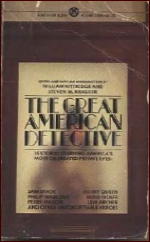
Kittredge, William & Krauzer, Steven M. – The Great American Detective: 15 Stories Starring America’s Most Celebrated Private Eyes, New American Library, 1978.
This is the only anthology on my list which does not contain exclusive hard-boiled and noir stories. One of the two Black Mask stories is a detective tale about Race Williams by Carroll John Daly. Other hard-boiled stories feature Sam Spade (Hammett), Philip Marlowe (Chandler), Dan Turner (Rober Leslie Bellem), Michael Shayne (Brett Halliday), Lew Archer (Ross Macdonald) and Mack Bolan, the Executioner (Don Pendleton).
The second Black Mask story is contributed by Cornell Woolrich: “Angel Face.” But you find also tales of famous detectives like Nick Carter, The Shadow, Ellery Queen, Nero Wolfe, Perry Mason and others which are not hard-boiled. The book has a very interesting introduction of 24 pages by the editors, contains short notes before each story and some suggestions for further reading in the final chapter.
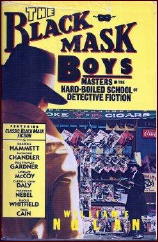
Nolan, William F. – The Black Mask Boys: Masters in the Hard-Boiled School of Detective Fiction, The Mysterious Press, 1987.
The book begins with a short history of Black Mask magazine. Then comes the first hard-boiled detective tale ever printed: “Three Gun Terry,” by Carroll John Daily. It is followed by the most bloodthirsty story which Hammett has ever written: “Bodies Piled Up.”
The other stories are also written by big names: Erle Stanley Gardner, Raoul Whitfield, Frederick Nebel, Horace McCoy, Paul Cain and Raymond Chandler. Each story is combined with a lot of information about the author and his writing for Black Mask. At the end is a checklist of mystery-detective-crime pulp magazines.
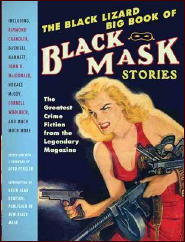
Penzler, Otto – The Black Lizard Big Book of Black Mask Stories. Vintage Books, 2010.
This voluminous book has 1116 pages. Containing 53 stories this anthology “is the biggest and most comprehensive collection of pulp crime fiction ever published,” writes Penzler in his foreword. The introduction is by Keith Alan Deutsch, copyright owner of Black Mask Magazine.
The collection includes the original version of Hammett’s The Maltese Falcon. Lester Dent’s story “Luck” is in print for the first time. Besides the “usual suspects” there is a lot of reading material you would not expect: stories by Stewart Sterling, Talmadge Powell, Charles G. Booth, Richard Sale, Katherine Brocklebank, Thomas Walsh, Dwight V. Babcock, Cleve F. Adams, Day Keene, W. T. Ballard, Hugh B. Cave, C. M. Kornbluth, Cornell Woolrich and many others. There are also several names I have never heard of. All in all very good value for the price of $25.00.
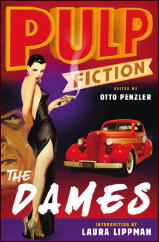
Penzler, Otto – Pulp Fiction: The Dames, Quercus 2008.
This is one of three anthologies of pulp fiction edited by Penzler in 2008. The other two books concern “Villains” and “Crimefighters.” The “Dames” anthology is for me the most interesting book. It is introduced by crime writer Laura Lippman.
Besides the star authors Hammett, Chandler, Woolrich one can read fine pulp stories by writers like Eric Taylor, Randolph Barr, Robert Reeves, Roger Torrey, Eugene Thomas, T. T. Flynn and some really unknown pulp fiction writers, altogether 23 stories. At the beginning of every story is a short note about the author and his text. So you get a lot of information about pulp fiction. There is also a comic strip “Sally The Sleuth” by Adolphe Barreaux.
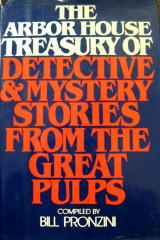
Pronzini, Bill – The Arbor House Treasury of Detective and Mystery Stories from the Great Pulps, Arbor House, 1983.
The anthology contains 15 stories and an informative introduction about the history of the pulps. Besides the big names like Hammett, Horace McCoy, Fredric Brown, Cornell Woolrich, John D. MacDonald (twice) etc. there are stories by rather unknown writers like Dane Gregory, D. L. Champion.
A highlight is “Holocaust House,” by Norbert Davis, the first story about private eye Doan and his dog Carstairs. Each story is combined with an informative note. So the reader can learn a lot about pulps.
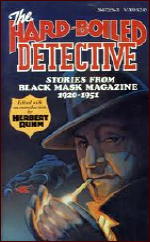
Ruhm, Herbert – The Hard-Boiled Detective. Stories from Black Mask Magazine 1920-1951, Vintage Books, 1977.
The book contains 14 stories and a lucid introduction of 28 pages. Besides the big names there are tales by not so well-known or meanwhile forgotten writers as Norbert Davis, Lester Dent, George Harmon Coxe, Merle Constiner, Curt Hamlin, Paul W. Fairman, Bruno Fischer and the humorous William Brandon.
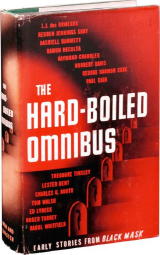
Shaw, Joseph T. – The Hard-Boiled Omnibus: Early Stories from Black Mask, Simon & Schuster, 1946; Pocket Books, 1952.
The book is introduced by the legendary Black Mask editor Shaw himself, the man who shaped the magazine’s hard-boiled style more than any other editor. Especially he promoted Hammett and encouraged other writers to follow his literary model.
The hardcover edition contains 15 stories, the paperback only 12. Besides well-known stories by Hammett, Chandler, Cain, Dent and Norbert Davis’s “Red Goose,” there are rather unknown tales by Reuben Jennings Shay, Ed Lybeck, Roger Torrey, Theodore Tinsley and others. A historical milestone.
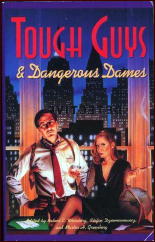
Weinberg, Robert E., Dziemianowicz, Stefan & Greenberg, Martin H. – Tough Guys & Dangerous Dames, Barnes & Noble Books, 1993.
The 24 pulp stories comprehend well-known authors like Chandler, Whitfield, Dent, Gardner, Paul Cain, John D. MacDonald as well as forgotten or unknown writers like Fred MacIsaac, Paul Chadwick, Donald Wandrei and others. The story by Norbert Davis, “Murder in the Red,” is not often reprinted.
Unusual for an anthology of this kind are also names like Fritz Leiber, Leigh Brackett and Robert Bloch. The reader gets some useful information about the contributors from the introduction by Dziemianowicz.
Wed 25 Jul 2012
IT’S ABOUT CRIME, by Marvin Lachman
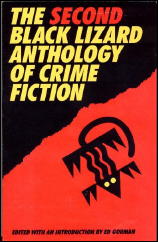
Black Lizard’s first mystery anthology included the [Harlan] Ellison Edgar winner, “Soft Monkey.” The Second Black Lizard Anthology of Crime Fiction, edited by Ed Gorman (trade paperback, 1988), is 664 pages long with thirty-eight short stories and a full-length novel, Murder Me for Nickels, by Peter Rabe.
Most of the stories are reprints, but the list of authors reads like a Who’s Who of hardboiled detective fiction for the last thirty-five years, including Avallone, Max Allan Cdllins, Estleman, Gault, Hensley, Lutz, McBain, Pronzini, Spillane, Willeford, et al.
Of the book’s three new stories, I especially liked Jon Breen’s baseball mystery about a streaker (remember them?).
There is also a Hall of Fame quality to The Mammoth Book of Private Eye Stories, edited by Bill Pronzini and Martin H. Greenberg (Carroll & Graf, trade paperback, 1988), which in its 592 pages offers stories about almost every important private eye, including Philip Marlowe in “Wrong Pigeon,” the last story Chandler wrote.
Only Hammett (readily available elsewhere) seems to be missing among the authors who include current masters like Hansen, both Collinses (Michael and Max Allan), Lutz, Pronzini, Muller, Estleman, and Grafton. The editors also dug out early work by Carroll John Daly, Robert Leslie Bellem, Fredrick Brown, Gault, McBain, and Prather, as well as rarities: a Paul Pine story by Howard Browne and a private eye story by Ed Hoch, who doesn’t usually write in that genre.
— Reprinted from The MYSTERY FANcier,
Vol. 11, No. 1, Winter 1989.
Editorial Notes: A complete list of authors for the Black Lizard anthology is as follows: Stories by Michael Avallone, Timothy Banse, Robert Bloch, Lawrence Block, Ray Bradbury, Jon Breen, Max Allan Collins, William R. Cox, John Coyne, Wayne D. Dundee, Harlan Ellison, Loren D. Estleman, Fletcher Flora, Brian Garfield, William C. Gault, Barry Gifford, Joe Gores, Ed Gorman, Joe L. Hensley, Joe R. Lansdale, Richard Laymon, John Lutz, Ed McBain, Steve Mertz, Arthur Moore, Marcia Muller, William F. Nolan, Bill Pronzini, Ray Puechner, Peter Rabe, Robert Randisi, Daniel Ransom, Mickey Spillane, Donald Westlake, Harry Willeford, Will Wyckoff, Chelsea Quinn Yarbro.
Contents for the “Mammoth” collection:
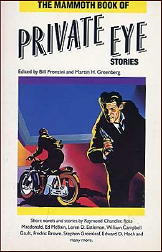
Raymond Chandler, ‘Wrong Pigeon’ [aka ‘The Pencil’] (1971: Philip Marlowe)
Carrol John Daly, ‘Not My Corpse’ (Race Williams)
Robert Leslie Bellem, ‘Diamonds of Death’ (Dan Turner)
Fredric Brown, ‘Before She Kills’ (1961: Ed and Am Hunter)
Howard Browne, ‘So Dark For April’ (1953: Paul Pine)
William Campbell Gault, ‘Stolen Star’ (1957: Joe Puma)
Ross Macdonald, ‘Guilt-Edged Blonde’ (1953: Lew Archer)
Henry Kane, ‘Suicide is Scandalous’ (1947: Peter Chambers)
Richard S. Prather, ‘Dead Giveaway’ (1957: Shell Scott)
Joseph Hansen, ‘Surf’ (1976: Dave Brandsetter)
Michael Collins, ‘A Reason To Die’ (1985: Dan Fortune)
Ed McBain, ‘Death Flight’ (1954: Milt Davis)
Stephen Marlowe, ‘Wanted — Dead and Alive’ (1963: Chester Drum)
Edward D. Hoch, ‘The Other Eye’ (1981: Al Darlan)
Stuart M. Kaminsky, ‘Busted Blossoms’ (1986: Toby Peters)
Lawrence Block, ‘Out of the Window’ (1977: Matt Scudder)
John Lutz, ‘Ride The Lightning’ (1985: Alo Nudger)
Sue Grafton, ‘She Didn’t Come Home’ (1986: Kinsey Millhone)
Edward Gorman, ‘The Reason Why’ (1988: Jack Dwyer)
Stephen Greenleaf, ‘Iris’ (1984: John Marshall Tanner)
Bill Pronzini, ‘Skeleton Rattle Your Mouldy Leg’ (1985: Nameless Detective)
Marcia Muller, ‘The Broken Men’ (1985: Sharon McCone)
Arthur Lyons, ‘Trouble in Paradise’ (1985: Jacob Asch)
Max Allan Collins, ‘The Strawberry Teardrop’ (1984: Nate Heller)
Robert J. Randisi, ‘The Nickel Derby’ (1987: Henry Po)
Loren D. Estleman Greektown’ (1983: Amos Walker)
Sun 15 Apr 2012
A 1001 MIDNIGHTS Review
by Charles Shibuk
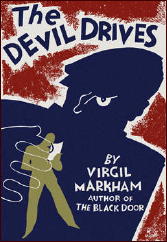
VIRGIL MARKHAM – The Devil Drives. Alfred A. Knopf, hardcover, 1932. Bart House #10, paperback, 1944. Ramble House, trade paperback, 2007.
The Devil Drives is an offbeat and highly individual novel by a writer who, it would seem, must have had some familiarity with the work of that master American zany Harry Stephen Keeler. It is somewhat reminiscent of Keeler’s Amazing Web (1929), but is shorter, slighter, less ambitious, more straightforward, and, though complex enough in plot, lacks the unbelievable convolutions and ramifications of the Keeler work.
The authors do share the ability to propel their narratives forward in such a manner that readers will keep turning pages breathlessly in order to discover what astounding plot development will next occur, and what outrageous coincidence will help to resolve (or amplify) the current situation.
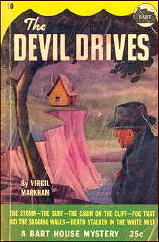
The Markham novel concerns George Lawson Peters, the warden of Franklin Penitentiary in New Jersey, who deserts his post to seek a lost treasure left by an adventurer nicknamed “Dubrosky” for a girl named Philadelphia Boston. On his odyssey, Peters meets a gangster with a heart of garbage; a repulsive blackmailer who exacts no tribute from his victims; the blackmailer’s unhappy wife; her friend the eccentric countess; and Detective Veen, who reads mysteries.
At the two-thirds point in the narrative, Peters encounters a honey of a locked-room problem. The door is locked and bolted, and the two windows are locked-all from the inside. The floor and ceiling are ungimmicked, and the fireplace and chimney show no signs of entrance or egress. The victim met his death by drowning. The author’s unique solution is even more bizarre than the problem he has propounded.
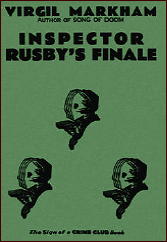
The locked-room situation and many strands of the plot are finally resolved by a few well-placed Keeleresque coincidences. But Markham has still done an ingenious job of deceptive clue-planting that is worthy of Christie, Carr, or Queen; and his unexpected and grimly ironic finale is worthy of Francis Iles or Richard Hull.
Markham’s other novels include Death in the Dusk (1928), The Black Door (1930), and Inspector Rusby’s Finale (1933). The last-named title has an irresistible premise:
A Scotland Yard inspector, spending a weekend at a crowded country house, wakes up the morning after his arrival to find that the hostess and guests have vanished and he is alone — except for the dead body of a perfect stranger. The ending, however, as Barzun and Taylor have noted, is a bit hard to swallow.
———
Reprinted with permission from 1001 Midnights, edited by Bill Pronzini & Marcia Muller and published by The Battered Silicon Dispatch Box, 2007. Copyright © 1986, 2007 by the Pronzini-Muller Family Trust.
Editorial Comments: Curt Evans recently posted on his blog a review of Red Warning (aka Song of Doom in the UK), another work of crime fiction by Virgil Markham. Included with the review is a considerable amount of information about the author himself, and I highly recommend it to you. (Follow the link.)
More. A link on Curt’s blog led to blogger TomCat’s review of Death in the Dusk, also by Markham, which he says “turned out to be a rival for Joel Townsley Rogers’ The Red Right Hand (1945) and Fredric Brown’s Night of the Jabberwock (1950) in the race for the title of most outlandish detective story ever contrived.”
Mon 17 Oct 2011
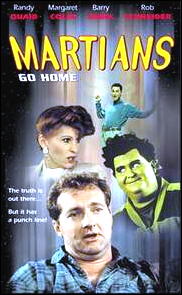
MARTIANS GO HOME. 1990. Randy Quaid, Margaret Colin, Anita Morris, John Philbin, Ronnie Cox. Based on the novel by Fredric Brown. Director: David Odell.
There may not be any underlying significance in what happens in this science fiction movie — it’s about an invasion of obnoxious green Martians who know everybody’s secrets, to their great rollicking delight — but there’s certainly thirty minutes worth of good laughs in their antics.
As far as how they get here, the composer of theme music for TV shows accidentally sends a message into space inviting then to cane visit our planet, and so they come — by the millions! (Truth in advertising. We see only about a dozen of them at different times on the screen — this is not a big budget movie.)
Bedrooms are not safe, the president’s office can’t keep them out, they’re all over the world; and they’re here to stay until our hero can find out a way to get rid of them. “Invaders can be dealt with. These guys are tourists!”
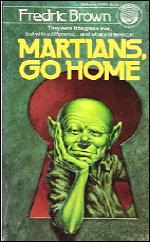
I think the book may have been clearer on one point, though — sorry, it’s been 30 or 40 years since I read the book – that human society exists only by maintaining secrecy and privacy and (therefore) complete dishonesty in all our affairs.
It’s a cynical point, and even though I enjoyed the movie, I think it’s one the people involved in making it let slip right through their fingers.
— Reprinted from Mystery*File 33, September 1991 (slightly revised).
[UPDATE] 10-17-11. While I was researching the credits for this movie on IMDB, I discovered that I must be one of the elite. There are perhaps only four or five people in the world who have liked this movie, and I am one of them.
It has been released as a Region Two DVD in the UK, but I’ve found a copy on VHS, and it’s on its way to me now. With Margaret Colin in it, really how bad could it be? (That’s assuming I was wrong about it the first time, which I am not conceding.)

























